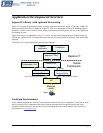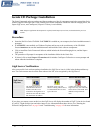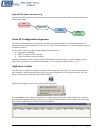
Genie Monochrome Series-GigE Vision Camera Installing the Genie Camera • 17
Installing the Genie Camera
Warning! (Grounding Instructions)
Static electricity can damage electronic components. Please discharge any static electrical charge by touching a
grounded surface, such as the metal computer chassis, before performing any hardware installation.
If you do not feel comfortable performing the installation, please consult a qualified technician.
GigE Network Adapter Guideline
If the computer to be used with the Genie camera does not have a Gigabit network adapter or second built in Gigabit
NIC, a PCI bus Gigabit NIC needs to be installed. Typically under Windows XP the PCI Gigabit NIC is recognized
automatically when Windows boots. An example of a high performance NIC is the Intel PRO/1000 MT adapter.
Review the NIC documentation concerning any special driver required for Windows. Install the PCI bus Gigabit
NIC as described by the NIC manufacture's documentation.
The Genie camera has been tested with a variety of Gigabit network adapters, both built into the system
motherboard and as third party PCI adapters.
Supported Network Configurations
The Genie obtains an IP address using the Link Local Address (LLA) or DHCP, by default. If required, a persistent
IP address can be assigned (see "
Running the Network Configuration Tool" on page 26).
The LLA method automatically assigns the Genie with a randomly chosen address on the 169.254.xxx.xxx subnet.
After an address is chosen, the link-local process sends an ARP query with that IP onto the network to see if it is
already in use. If there is no response, the IP is assigned to the device, otherwise another IP is selected, and the ARP
is repeated. Note that LLA is unable to forward packets across routers.
Alternatively, if a DHCP server is present on the network, the Genie is going to issue a DHCP request asking for an
IP address. The DHCP server will then provide the Genie an IP address.
Using Genie with Ethernet Switches
Examples where a Gigabit Ethernet switch would be used are:
• Multiple Genie cameras are controlled by one computer and a single NIC (running multiple instances of
CamExpert as an example of the control program).
• Multiple Genie cameras are individually controlled by multiple computers, all located on the same subnet.
In these cases the Ethernet switch is a transparent device. The device discovery process finds all Genie cameras, and
presents them as ready to be controlled by an application such as CamExpert.


















